Myopia Control
Myopia Control
What is Myopia?
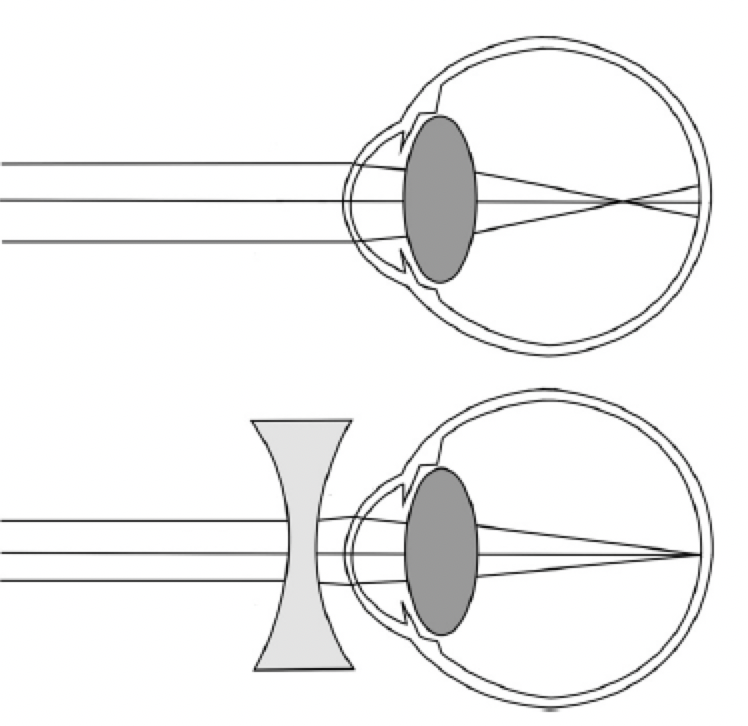 Often referred to as short-sightedness, myopia is an eye condition where distant objects appear blurred while closer objects are clear. It is most commonly a result of the eye growing too 'long' meaning that images of distant object come into focus in front of the retina. As objects are brought closer to the eye the focal point also moves closer to the retina making the image clearer. The two main factors leading to development of myopia are genetics (myopic parents) and lifestyle (low levels of outdoor activity and prolonged near tasks) [1] [2]
Often referred to as short-sightedness, myopia is an eye condition where distant objects appear blurred while closer objects are clear. It is most commonly a result of the eye growing too 'long' meaning that images of distant object come into focus in front of the retina. As objects are brought closer to the eye the focal point also moves closer to the retina making the image clearer. The two main factors leading to development of myopia are genetics (myopic parents) and lifestyle (low levels of outdoor activity and prolonged near tasks) [1] [2]
Myopia above -6.00D has previously been referred to as high myopia. While once myopia was considered more of an inconvenience it is now considered to be a disease due to its association with various other sight threatening conditions. There is no evidence of a 'safe' level of myopia with regard to these conditions [3]. Myopia is traditionally corrected with spectacles or contact lenses.
Myopia Prevalence
Myopia is becoming increasingly common in our population with an estimated 30% of the world being short-sighted. Based on current trends, by 2050 this is likely to increase to 50% (5 billion) with 1 billion being high myopes.[4] [5]
One in four Australians are estimated to be short-sighted,[5] with this predicted to increase to 36% by 2020 and 55% by 2050.[4] An Australian population study published in 2013 revealed that 8.6% of children aged 12 and 17.7% of 17 year olds were myopic.[6] It was once thought that myopia stopped progressing at around the age of 18, many modern studies have demonstrated a continued progression through the 20s and into the 30s.[2] [7]
Myopia is a progressive condition that is occurring in children at a younger age than previously observed. These factors combine to make myopia more wide-spread in our society. As the rate of myopic progression is faster in younger children, the younger the onset of myopia the more the likelihood that a child will develop high myopia.[1] [3] [8] [9]
Risks Associated with Myopia
Myopia is a result of excessive elongation of the eye. This 'stretching' of the eye and the structures within the eye results in an increased risk of various vision threatening diseases including cataract, glaucoma, retinal detachment and myopic maculopathy.[2] [3] [4] The risk of these diseases increases with increasing levels of myopia. Currently we have an epidemic of myopia with growing rates of high myopia [4] [10] meaning increased risk of blindness in our population.
Every 1 dioptre(D) increase in myopia is associated with a 67% increase in the risk of myopic maculopathy. For each dioptre that the final level of myopia is reduced by (once the eye has stopped growing), the risk of blinding eye diseases like myopic maculopathy are reduced by 40%. This effect is independent of the magnitude of short-sightedness.[11] This highlights the need for interventions to reduce the rate that myopia worsens, meaning that when a child reaches adulthood the level of myopia is lower than it would have been otherwise. [3] Interventions should occur as early as possible to prevent the vision threatening complications later in life. [2] [3] [9]
Myopia Control Options
There are many Myopia Control options or interventions which can effectively slow the rate of progression of myopia. These include:
- Environmental modifications
- Specialised prescription glasses
- Orthokeratology (orthok)
- Specially designed multifocal contact lenses
- Atropine eye drops
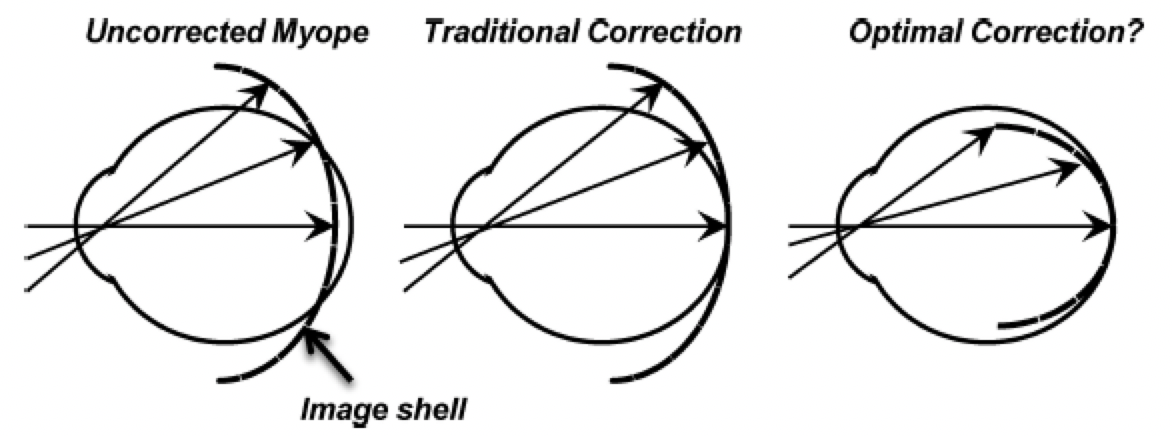 One possible mechanism for myopic progression appears to be peripheral hyperopic (long-sighted) defocus (blurriness)[12], where when an image is focused on the central retina for clear vision and the peripheral image falls behind the retina due to the curvature of the back of the eye. This actually stimulates the eye to grow longer in order to eliminate this peripheral blur.[3] [12] Many of the successful myopia control strategies are aimed at dealing with this peripheral hyperopic defocus.[2]
One possible mechanism for myopic progression appears to be peripheral hyperopic (long-sighted) defocus (blurriness)[12], where when an image is focused on the central retina for clear vision and the peripheral image falls behind the retina due to the curvature of the back of the eye. This actually stimulates the eye to grow longer in order to eliminate this peripheral blur.[3] [12] Many of the successful myopia control strategies are aimed at dealing with this peripheral hyperopic defocus.[2]
- Environmental Modifications

The more time a child spends outdoors in natural light the less likely they are to become short-sighted. The lowest rate of myopia is observed in children who spend more time outdoors with sport and leisure activities. Myopia is more common in children who spend long periods indoors performing near activities. [3] [10] [13] [14] It has been demonstrated that it is actually the exposure to higher light levels in the outdoor environment that is protective against the development of myopia [15] rather than physical activity.[16] Higher levels of illumination indoors have been shown to be protective against the development of myopia.[17]
- Specialised Prescription Glasses
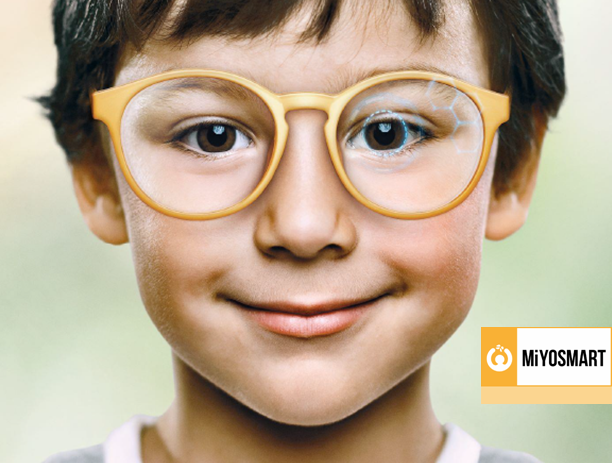
Previously it was thought that under-correction of myopia would assist in slowing progression, however a number of studies have proven that this strategy actually accelerates the rate of progression.[3] [18] [19] This is likely due to the fact that a clear image is required to appropriately regulate eye growth and the level of under-correction required for useful vision still results in peripheral hyperopic defocus.[2]
Bifocals have been demonstrated to reduce myopic progression in some children by around 20- 39%.[20] [23] Mulitfocal spectacles can slow myopic progression when compared to single vision spectacles. This is thought to be due to the multifocal reading section correcting peripheral blur in part of a wearers vision.[21] [22] However, the level of myopia control falls short of what might be considered to have a meaningful benefit.[23]
The MiyoSmart spectacle lens from Hoya has been shown to slow progression of myopa by up to 60%. The lens uses DIMS technology to correct the peripheral hyperopic defocus.
- Orthokeratology
While normal contact lens wear does nothing to slow the rate of progression of myopia[24] [25], orthokeratology (orthok) has been demonstrated in a number of studies to do this very effectively.[2] [26] [27] [28] [29] [30]
Orthok involves the use of specially designed hard contact lenses that are worn while sleeping which flatten the central corneal surface. This means that when the lenses are removed in the morning, vision is corrected and no additional glasses or contact lenses are required during waking hours. The lenses also induce a steepening of the peripheral corneal surface. This corrects the peripheral hyperopic defocus reducing the stimulus for further eye elongation.[3] [31] [32] [33]
Orthok can slow the rate of myopic progression by 43-100%[22] [30]. Even partial correction of high myopia with orthok, using glasses to correct the rest, has been shown to reduce the rate of eye elongation by 63%.[34]
In addition to the slowing of myopic progression, orthok also provides significant improvements in quality of life, giving freedom from glasses and contact lenses during waking hours. This is particularly advantageous for contact sports and water sports and for people who suffer from discomfort with day wear contact lenses.[35]
- Multifocal Contact Lenses
It is possible to create a similar optical effect to orthok using soft contact lenses with multifocal optics.(Cooper) Such contact lenses have demonstrated 30-38% control of myopic progression.[29] [36] The Coopervision MiSight and Visioneering Technologies NaturalVue lenses correct both the short-sightedness and the peripheral hyperopic defocus. These have been demonstrated to be even more effective at slowing the rate of myopic progression than standard multifocal contact lenses.[37]
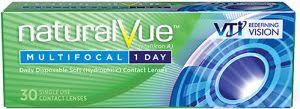
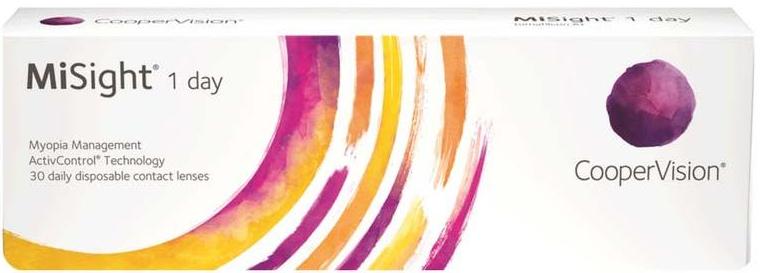
- Atropine
Atropine eye drops have been used for myopia control since at least the early 1900s. While 1% atropine (its commercially available form) is very effective at slowing myopic progression, it causes significant side-effects such as pupil dilation and paralysis of focusing for a sustained period of time. Due to the increased brightness and UV exposure as well as the inability to focus on near objects, children being treated with this method need to be prescribed photochromatic bifocal or multifocal glasses with UV filters.[2] [38] [39] [40]
More recently lower dosages of atropine have been used for the treatment of myopic progression. While the lower dosages reduce the side-effects, the effect on myopia control also reduces. (ATOM 2) It is now common-place to use dosages of 0.01% for myopia control, however the slowing of the rate of eye growth is questionable.[2] [41]
[1] The Australia and New Zealand Child Myopia Report: A Focus on Future Management
[2] Cooper J. A Review of Current Concepts if the Etiology and Treatment of Myopia. Eye & Contact Lens. 2018;44:231-247
[3] Flitcroft DI. The complex interactions of retinal, optical and environmental factors in myopia aetilogy. Prog Retin Eye Res. 2012 Nov;31(6):622-60
[4] Holden BA, Fricke TR, Wilson DA, Jong M, Naidoo KS, Sankaridurg P, Wong TY, Naduvilath TJ, Resnikoff S. Global Prevalence of Myopia and High Myopia and Temporal Trends from 2000 through 2050. Ophthalmology 2016 May;123(5):1036-42
[5] Australian Institute of Health and Welfare 2016. Australia's health 2016. Australia's health series no. 15. Cat.no.AUS 199. Canberra LAIHW. Adults stats section 3.15, pg 117. Child stats secion 5.4, pg 3
[6] French AN, Morgan IG, Burlutsky G, Michell P, Rose KA. Prevalence and 5- to 6-Year Incidence and Progression of Myopia and Hyperopia in Australian Schoolchildren. Opthalmology 2013 July;120(7):1482-91
[7] Bullimore MA, Jones LA, Moeschberger ML, et al. A retrospective study of myopia progression in adult contact lens wearers. Invest Ophthalmol Vis Sci 2002;43:2110-2113
[8] Chua SY, Sabanayagam C, Cheung YB et al. Age of onset of myopia predicts risk of high myopia in later childhood in myopic Singapore children. Ophthalmic Physiol Opt 2016;36:388-394
[9] Cho P, Qi Tan. Myopia and orthokeratology for myopia control. Clin Exp Optom 2019; 102:364-377
[10] Morgan IG, French AN, Ashby RS, Gui X, Ding X, He M, Roce KA. The epidemics of myopia: Aetiology and prevention. Prog Retin Eye Res. 2018 Jan;62:134-149
[11] Bullimore MA, Brennan NA. Myopia Control Why Each Diopter Matters. Optometry and Vision Science.2019 Jun;96(6):463-465
[12] Smith EL 3rd. Prentice award lecture 2010:a case for peripheral optical treatment strategies for myopia. Optom Vis Sci 2011;88(9):1029-1044
[13] Rose KA, Morgan IC, Ip J, Kifley A, Huynh S, Smith W, Mitchell P. Outdoor activity reduces the prevalence of myopia n children. Ophthalmology 2008;115(8):1279-1285
[14] Rose KA, French AN, Morgan IG. Environmental Factors and Myopia: Paradoxes and Prospects for Prevention. Asia Pac J Ophthalmol (Phila). 2016;5(6):403-410
[15] Smith EL, Hung LF, Huang J. Protective Effects of High Ambient Lighting on the Development of Form-Deprivation Myopia in Rhesus Monkeys. Invest Ophthalmol Vis Sci. 2012;53:421-428
[16] Guggenheim JA, Northstone K, McMahon G, Ness AR, Deere K, Mattocks C, St Pourcain B, Williams C. Time Outdoors and Physical Activity as Predictors of Incident Myopia in Childhood: A Prospective Cohort Study. Ophthalmol Vis Sci. 2012;53:2856-2865
[17] Hua WJ, Jin JX, Wu XY, Yang JW, Jianng X, Gao GP, Tao FB. Elevated light levels in schools have a protective effect on myopia. Ophthalmic Physiol Opt. 2015;35:252-62
[18] Chung K, Mohidin N, O'Leary DJ. Undercorrection of myopia enhances rather than inhibits myopia progression. Vision Res 2002:42;2555-9
[19] Adler D, Millodot M. The possible effect of undercorrection on myopic progression in children. Clin Exp Optom 2006;89:315-21
[20] Cheng D, Woo GC, Drobe B, et al. Effect of bifocal and prismatic bifocal spectacles on myopia progression in children:three-year results of a randomized clinical trial. JAMA Ophthalmol 2014;132:258-264
[21] Bernsten DA, Barr CD, Mutti DO, Zadnik K. Peripheral Defocus and Myopia Progression in Myopic Children Randomly Assigned to Wear Single Vision and Progressive Addition Lenses. Invest Ophthalmol Vis Sci 2013;54(8):5761-5770
[22] Walline JJ. Myopia Control: A Review. Eye & Contact Lens 2016;42:3-8
[23] Fulk GW, Cyert LA, Parker DE. A Randomized Trial of the Effect of Single-Vision vs. Bifocal Lenses on Myopia Progression in Children with Esophoria. Optometry Vis Sci 2000;77(8):395-401
[24] Walline JJ, Jones LA, Mutti DO et al. A Radnomized trial of the effects of rigid contact lenses on myopia progression. Arch Ophthalmol 2004;122:1760-1766
[25] Walline JJ, Jones LA, Sinnott L, et al. A radnomized trial of the effect of soft contact lenses on myopia progression in children. Invest Ophthalmol Vis Sci 2008;49:4702-4706
[26] Si JK, Tang K, Bi HS, et al. Orthokeratologry for myopia control: A meta-analysis. Optom Vis Sci 2015;92:252-257
[27] Kwok-Hei Mok A, Sin-Ting Chung C. Seven-year retrospective analysis of the myopic control effect of orthokeratology in children: A pilot study. Clin Optom 2011;3;1-4
[28] Hiraoka T, Kakita T, Okamoto F, et al. Long-term effect of overnight orthokeratology on axial lenth elongation in childhood myopia: A 5-year follow-up study. Invest Ophthalmol Vis Sci 2012;53:3913-3919
[29] Turnbull PRK, Munro OJ, Phillips JR. Contact Lens Methods for Clinical Myopia Control. Optom Vis Sci 2016;93:1120-1126
[30] Kang P. Optical and pharmacological strategies of myopia control. Clin Exp Optom 2018;101:321-332
[31] Cho P, Cheung SW, Edwards M. The longitudinal orthokeratology research in children (LORIC) in Hong Kong: a pilot study on refractive changes and myopic control. Curr Eye Res 2005;30:71-80
[32] Kakita T, Hiraoka T, Oshika T. Influence of overnight orthokeratology on axial elongation in childhood myopia. Invest Ophthalmol Vis Sci 2011;52:2170-2174
[33] Walline JJ, Jones LA, Sinnott LT. Corneal reshaping and myopia progression. Br J Ophthalmol 2009;93:1181-1185
[34] Charm J, Cho P. High Myopia-Partial Reduction Ortho-k: A 2-Year Randomized Study. Optom Vis Sci 2013;90:530-539
[35] Zhao F, Zhao G, Zhao Z. Investigation of the Effect of Orthokeratology Lenses on Quality of Life and Behaviours of Children. Eye Contact Lens 2018 Soe;44(5):335-338
[36] Li S, Kang M, Wu S, Meng B, Sun Y, We S, Liu L, Peng X, Chen Z, Zhang F, Wang N. Studies using concentric ring bifocal and peripheral add multifocal contact lenses to slow myopia progression in school-aged children:a meta-analysis. Ophthalmic Physiol Opt 2017;37:51-59
[37] Cooper J, O’Connor BO, Watanabe R, Fuerst R, Berger S, Eisenberg N, Dillehay SM. Case Series Analysis of Myopic Progression Control With a Unique Extended Depth of Focus Multifocal Contat Lens. Eye Contact Lens 2018;44: e16–e24
[38] Chua WH, Balakrishnan V, Chan YH, Tong L, Ling Y, Quah BL, Tan D. Atropine for the Treatment of Childhood Myopia. Ophthalmology 2006;113:2285-2281
[39] Chia A, Chua WH, Cheung YB, Wong WL, Lingham A, Fong A, Tan D. Atropine for the Treatment of Childhood Myopia: Safety and Efficacy of 0.5%, 0.1%, and 0.01% Doses (Atropine for the Treatment of Myopia 2). Ophthalmology 2012;119:347-354
[40] Chia A, Lu QS, Tan D. Five-Year Clinical Trial on Atropine for the Treatment of Myopia 2. Ophthalmology 2016;123:391-399
[41] Yam JC, Jiang Y, Tang SM, Law AKP, Chan JJ, Wong E, Ko ST, Young AL, Tham CC, Chen LJ, Pang CP. Low-Concentration Atropine for Myopia Progression (LAMP) Study. Ophthalmology 2019;126:113-124

